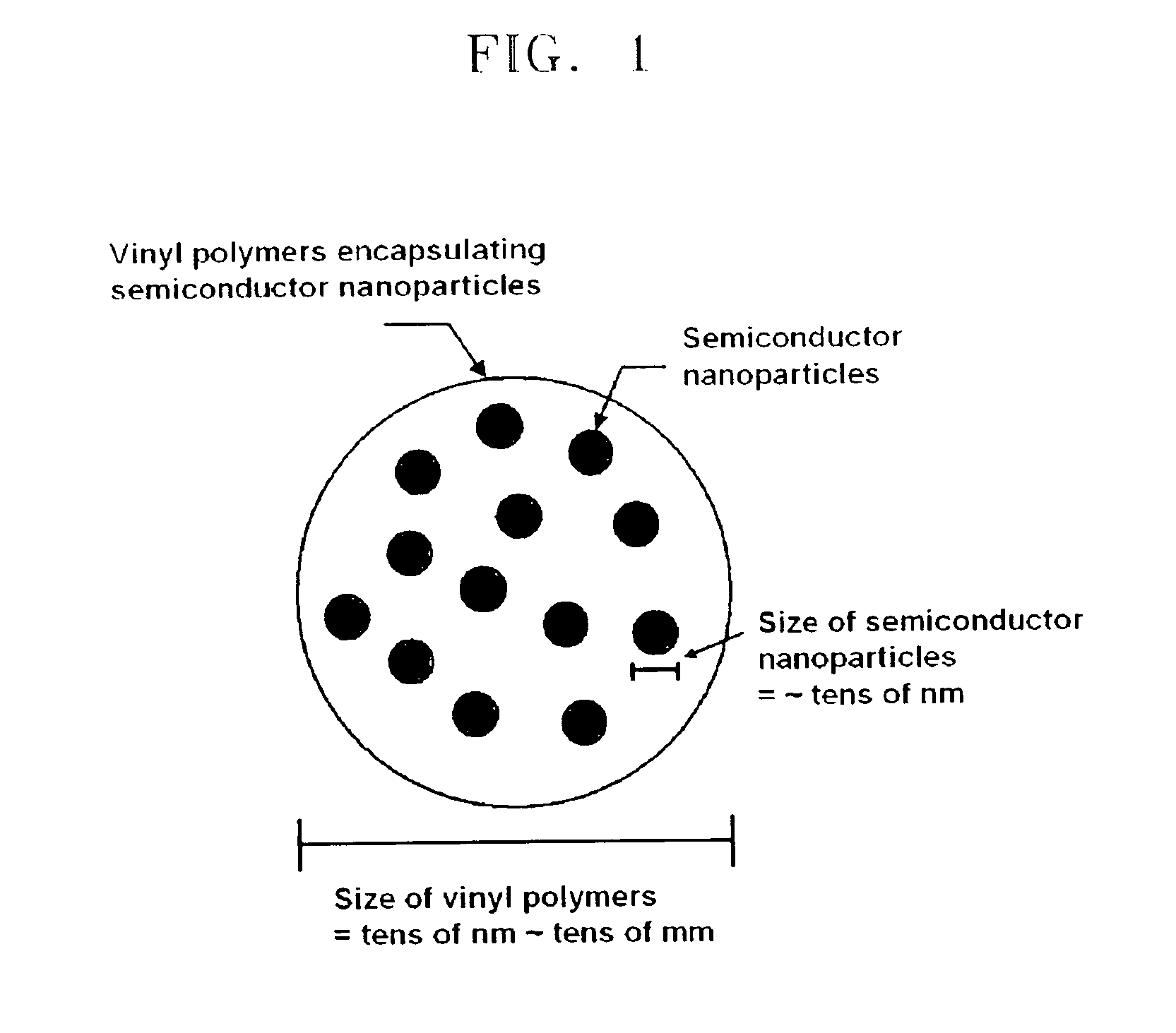Semiconductor nanoparticle-encapsulating vinyl polymer, vinyl polymer mixture including same, and process of preparing the same
a technology of semiconductor nanoparticles and vinyl polymers, which is applied in the direction of non-metal conductors, conductors, organic conductors, etc., can solve the problems of huge amount of vinyl polymer waste, inability to easily degrade synthetic polymers, and waste of synthetic polymer products, so as to achieve efficient enhancement of mechanical properties of vinyl polymer products, reduce the effect of dioxin emission during incineration and facilitate high-efficiency photodegradation
- Summary
- Abstract
- Description
- Claims
- Application Information
AI Technical Summary
Benefits of technology
Problems solved by technology
Method used
Image
Examples
example 1
[0061]In this Example, vinyl polymer particles encapsulating semiconductor nanoparticles were prepared by suspension polymerization. For this, TiO2 nanoparticles were used as the semiconductor nanoparticles and styrene was used as a vinyl monomer.
[0062]Additives used in this Example are presented in Table 1 below. In Table 1, a styrene monomer and polyvinylalcohol (PVA) were commercially available from Aldrich, TiO2 nanoparticles from Degussa under the trade name of P25, and azoisobutyronitrile (AIBN) from Junsei. As a dispersion stabilizer, there was used Solsperse 24000 (available from Avecia KK) having a number-average molecular weight of several thousands or more, a main chain incorporated therein a material such as a nitrogen atom or a sulfur atom having high affinity with the semiconductor nanoparticles, and multiple side chains having affinity with the styrene monomer.
[0063]First, the dispersion stabilizer was dissolved in the styrene monomer with stirring and the TiO2 nanopa...
example 2
[0065]In this Example, vinyl polymer particles encapsulating semiconductor nanoparticles were prepared by emulsion polymerization. For this, TiO2 nanoparticles were used as the semiconductor nanoparticles and styrene was used as a vinyl monomer.
[0066]The emulsion polymerization of this Example was performed in substantially the same manner as in Example 1 except that SLS (available from Aldrich) was used as an emulsifier instead of PVA used as the surfactant in Example 1 and potassium persulfate (KPS) (available from Aldrich) was used as an initiator. Compositional components used in this Example and their contents are presented in Table 1 below. A reaction emulsion was centrifuged at 27,000 rpm using a centrifuge for two hours to obtain solids. The solids were separated and dried to give polystyrene powders encapsulating TiO2 nanoparticles. DLS analysis and SEM image showed that a powder size was in the range from several tens nanometers to several micrometers. TEM analysis showed ...
example 3
[0067]In this Example, vinyl polymer particles encapsulating semiconductor nanoparticles were prepared by dispersion polymerization. For this, TiO2 nanoparticles were used as the semiconductor nanoparticles and styrene was used as a vinyl monomer.
[0068]The dispersion polymerization of this Example was performed in substantially the same manner as in Example 1 except that a mixture (94.5:5.5) of ethanol to deionized water was used as a dispersion medium and polyvinylpyrrolidone (PVP) (available from Aldrich) was used as an emulsifier instead of PVA used as the surfactant in Example 1. In addition, in this Example, instead of using the dispersion stabilizer (Solsperse) of Example 1, the TiO2 nanoparticles were used after being surface-modified with 3-methacryloxypropyltrimethoxysilane. Compositional components used in this Example and their contents are presented in Table 1 below. A reaction dispersion was centrifuged at 27,000 rpm using a centrifuge for two hours to obtain solids. Th...
PUM
| Property | Measurement | Unit |
|---|---|---|
| particle size | aaaaa | aaaaa |
| wt % | aaaaa | aaaaa |
| wt % | aaaaa | aaaaa |
Abstract
Description
Claims
Application Information
 Login to View More
Login to View More - R&D
- Intellectual Property
- Life Sciences
- Materials
- Tech Scout
- Unparalleled Data Quality
- Higher Quality Content
- 60% Fewer Hallucinations
Browse by: Latest US Patents, China's latest patents, Technical Efficacy Thesaurus, Application Domain, Technology Topic, Popular Technical Reports.
© 2025 PatSnap. All rights reserved.Legal|Privacy policy|Modern Slavery Act Transparency Statement|Sitemap|About US| Contact US: help@patsnap.com



